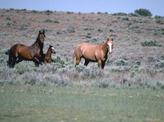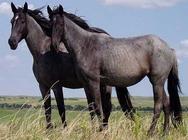 | ||||
Horse Behavior as a Prey Animal
from Science Prof Online
Plants, at the bottom of the food chain are eaten by herbivores, like horses. Then carnivores, the top ranking members of the food chain, eat the herbivores. Carnivores are most often predators, whereas plant-munching herbivores are always prey. So it's little wonder that horses can be a bit skittish.
In fact, the first interactions between humans and horses were predator-prey. Since that time, we've promoted the horse to its role as companion and co-worker. Still the horses prey
Article Summary: To understand equine behavior, it is important to remember that horses are prey animals, potential lunch for another organism.
Horse Psychology: Why Horses Spook Easily & Live Socially
Horses are prey animals and have a number of physical, mental and behavioral adaptations that serve their drive to survive.
 | ||||||
You have free access to a large collection of materials used in a college-level introductory Cell Biology Course. The Virtual Cell Biology Classroom provides a wide range of free educational resources including Power Point Lectures, Study Guides, Review Questions and Practice Test Questions.
SPO VIRTUAL CLASSROOMS
 | ||||||
 | ||||||
SPO is a FREE science education website. Donations are key in helping us provide this resource with fewer ads.
Please help!
(This donation link uses PayPal on a secure connection.)
Plants, at the bottom of the food chain are eaten by herbivores, like horses. Then carnivores, the top ranking members of the food chain, eat the herbivores. Carnivores are most often predators, whereas plant-munching herbivores are always prey. So it's little wonder that horses can be a bit skittish.
In fact, the first interactions between humans and horses were predator-prey. Since that time, we've promoted the horse to its role as companion and co-worker. Still the horses prey animal mentality persists, and horses have a number of physical, mental and behavioral adaptations that are a product of their drive to survive.
Why Horses are Social Animals
Consider the social grouping of most prey animals. If the species in question is not relying on the invisibility of camouflage, it is probably depending on speed or the safety of group membership. Herd life is a social arrangement that confers protection. Many vigilant eyes mean that predators are more likely to be spotted. When the time comes to flee, it's the animals that are too slow, or that stray from the group, that are usually taken down by predators. There is safety in numbers.
Why Horses Spook
With the horse's very vulnerable position in the food chain, it pays to be cautious. Things that surprise a horse will be perceived as a threat and inspire a fearful reaction. This terrifying stimulus can be a barking dog, an overzealous child, or, for skittish steeds, even a butterfly. Horses have great long-term memory as well, so something that frightens a horse, just once, may end up being an object of fear for a very long time.
Avoid Being a Perceived Threat
Like many prey animals, horses' eyes are located on the sides of their heads, giving them a large visual field. They cannot, however, see directly behind or in front of them. That is why it's best to approach a horse from the side, speaking softly to announce your presence.
When moving behind a horse, either give the back of the animal a wide berth or remain very close, touching the hindquarters the entire time you move from one side to the other. Physical contact helps the horse remember that you are there, and staying close benefits you in the event that the horse does kick. A short kick can't pack much power and is less likely to result in injury to the handler.
In addition to remembering how to properly approach and move around a horse, it's important to understand how to behave in general around them. As a prey animal, a horse may perceive any sudden movement, large gesture or loud noise, as a threat. Make sure your manner is confident, your movements slow and deliberate, and your voice soft and comforting. Although a firm voice is essential to use when giving a command or reprimand; it is the shrill, screeching screams of excited children and terrified adults that may launch a horse into panic and result in a dangerous situation.
Although mounts are much bigger than their handlers, in all interactions with horses we should remember that these gentle giants operate from a prey mentality.
Page last updated 9/2017
Sources and Other Helpful Animal Behavior & Equestrian Links
- Waring, G.H. (2002). Horse Behavior, William-Andrews Inc.
- Bradley, M., Professor, Department of Animal Sciences, University of Missouri-Columbia.
- Animal Behavior Wikibook
- ASPCA: Ask the Expert - Horse Behavior
- Equisearch: Website for People Who Love Horses


